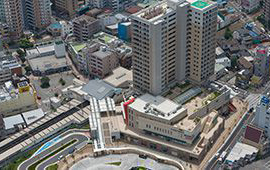Our BusinessEchika Omotesando Model Station Plan
Bringing the City of Paris to an Underground Concourse
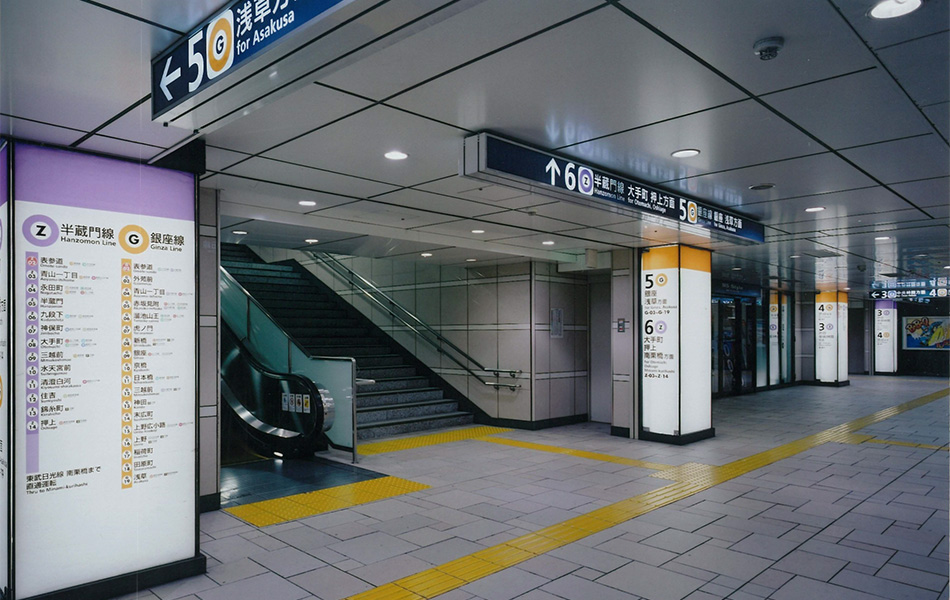
Echika Omotesando, a joint project by Tokyo Metro and Pacific Consultants that sparked a station building commercial development boom.
It was apparent that moving forward with construction work for new stores in an eki-chika area, literally "station underground" area, without suspending the operation of subway services was considerably difficult.
The shops including a delicatessen, juice bar, cosmetics and general fashion are full of customers who have casually stopped to appraise the goods on offer.
A Parisian market (Marché) that appeared within the underground station
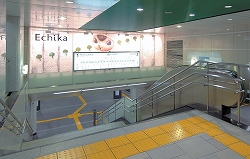
When you get off the subway and ride the escalator up from the platform, the scene instantly changes to warm, incandescent lighting. While the ceilings are low, the indirect ceiling lighting has been arranged effectively to give the impression that the area is more spacious than it is. The floor is covered in stone-like tiles, with fashion-oriented posters adorning the creamy white glass pillars. The shops including a delicatessen, juice bar, cosmetics and general fashion are full of female customers who have casually stopped to appraise the goods on offer. While this scene would not be out of place in an above-ground station building or department store, this area is still inside the ticket gates of a subway station.
Outside the ticket gates, a dining zone spreads out along the passageway to Omotesando. Marché de Metro, a food court that gives off the strong, alluring atmosphere of good old Paris, bustles with customers enjoying light meals and conversation until closing time. Meanwhile, the passage towards the Nezu Museum on the opposite side is the beauty zone, featuring a line of beauty-related services like hair and nail salons like one would see in Aoyama.
Echika Omotesando is a 1,300m2 commercial facility in Omotesando Station made up of 26 stores targetting a principally female audience in their 20s to 40s. This facility is used by about 10,000 of the roughly 140,000 passengers passing through Omotesando each day. Annual sales in the first year surpassed three billion yen and beat initial forecasts.
Echika Omotesando is the first example in Japan of successfully marrying rail facilities and appealing commercial space under the limited conditions of a subway station area. The endeavor has attracted attention not only in Japan, but from those in the rail industry around the world.
Parallel Investigation and Design Work
The birth of Echika Omotesando has its roots in the Omotesando Model Station Plan, envisaged as the main project in the first stage of Tokyo Metro’s privatization.
"For us at Pacific Consultants, this job was a significant achievement. It fell within our area of specialty as in supervising the design of an underground structure, but it also represented the new genre of planning a commercial facility targeting female customers," explained Kishi from Pacific Consultants, looking back on the project that lasted almost three years. Kishi had been responsible for everything from planning and proposal to design and construction supervision.
In 2003, Kishi was invited by the now-defunct Teito Rapid Transit Authority ("Eidan") to take part in a model station planning competition for Omotesando Station. Previously Kishi had developed a design for the complete renovation of Eidan’s Hongo-sanchome Station involving the parallel establishment of a convenience store and cafe, and the proposal was thanks to his achievements in that regard.
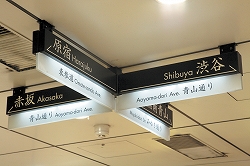
The plan had two themes: the new role of a station as a rail business facility, and the commercialization of excess space. Together with commercial consultants as partners, Kishi developed the "Breeze of Omotesando" concept. When you go aboveground from Omotesando Station, you arrive at the Harajuku version of Champs-Élysées, a beautiful tree-lined street full of brand stores that is likened to the Avenue des Champs-Élysées in Paris. Kishi’s proposal was to draw in that atmosphere to create an underground space that exhibited a sense of unity with the town above. As a result, Pacific Consultants won out over major advertising firms and design offices, was selected as the project partner, and began the plan to turn Omotesando Station into a slice of Paris.
A Concept of Linking the Underground Town with the Town Above
"In the design, we started by conducting passenger flow studies and group interviews. However, while the interviewees shared a lot of what they didn’t like about the facilities in their current form, describing an old station that was dark and had low ceilings, there was nothing about its future potential. It was as if no one had even thought about developing a commercial facility in a subway station." (Kishi)
As it turned out, the renovation of Omotesando Station involved some difficulties.
Omotesando Station serves the Ginza Line, the oldest subway line in Japan, and as the station had since been expanded with the Hanzomon and Chiyoda lines, it was extremely complex in terms of its underground structure. On top of that, there were only partial remnants of the old drawings. While confirming the conditions of building equipment in unseen areas by touch and making inferences based on fragmented materials, the team adopted the approach of performing checks through actual surveys in the field and proceeding with the design accordingly.
"On this point, being able to perform both structural surveys and design in-house was an advantage unique to Pacific Consultants," explains Kishi. Suzuki, an expert in underground structures, came on board from the Transportation Technology Division, and the team proceeded with the design of the new station while conducting soundness studies of the existing facilities, verifying disaster preparedness and developing a barrier-free design in parallel.
Innovation and Unique Design Born Out of Limitations
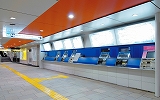
With the challenges unique to the facilities connected with subway stations, including the short construction times from the last train of the night to the first train of the next day, and layout limitations due to water mains, ventilation, heating and cooling and so on, Kishi and Suzuki had their hands full.
Time restrictions were dealt with by rationalizing construction methods as much as possible through the creation of construction units, the use of dry construction methods and the creation of construction switchover order plans. As a result, we managed to stick to the scheduled opening day.
The excess space that seemed disjointed at first glance was split into five areas comprising dining, beauty, merchandise, and so on. By performing purpose-specific zoning in this way, the station was transformed into unique commercial zones that are easy to get around and between.
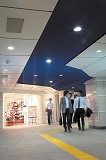
In designing the interior aspects, Kishi paid particular attention to reducing the sensation of narrow-ness that is unique to an old subway station.
"To revamp the dark and dreary image of the station, we innovated through a luminous ceiling and lighting presentations on illuminated walls to not only retain brightness in terms of conventional numerical value, but also project a sense of brightness. For structural reasons, we weren’t able to eliminate the thick pillars, so we transformed them with a translucent concept and the heavy use of glass."
On the ceiling, accented colors of orange and blue offer guidance to passengers who have lost their way in the bustle of activity. This represents an attempt to express the path to follow through signs built in to the architecture.
From Commercial Space Concept to Leasing
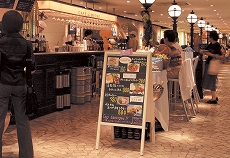
In tenant leasing efforts led by Tokyo Metro, a sense of unity with aboveground spaces was given priority. This took shape as the concept of "assembling a range of business categories to supplement shortages in the town."
As Omotesando does not have any department stores, there was a focus on shops dealing with cosmetics and fashion, and individual tenants that female customers would be prepared to use even on their own, such as quick hair styling for those with limited time, and somewhat classy fast food options.
As the Omotesando area is home to a large number of luxury stores, those looking for a rich feeling or fully-fledged service can make use of those services. The aim was for Echika to meet the potential needs of passengers looking for something quick and casual on their own.
Due to the location, more than 400 companies wanted to launch stores at the location, but Tokyo Metro carefully narrowed down the number of stores to 26 while taking the characteristics of Echika into account.
Transportation Figures from Around the World are Paying Close Attention to the Commercialization of Stations
With the dwindling birth rate and aging population, companies can no longer expect increased revenue from fares, and transportation companies are concentrating their brain power on efforts to expand revenue through new businesses. After hearing about the successes of Echika Omotesando, the subway operators of local cities around Japan have visited to see it in action, and Tokyo Metro opened the second iteration of Echika during fiscal 2008 in Ikebukuro.
Subway operators based in South Korea have also shown a strong interest, and approached Pacific Consultants directly.
In-station projects in South Korea have been undertaken by a single conglomerate and things may go fast once the project gets rolling. In terms of transportation infrastructure, commercial expansion is still possible if a company shifts its perspective. For our part, we are also looking to hone our sense of smell with regard to the services that society desires, and hope to further enhance our ability to develop proposes that take both structural and non-structural factors into account.
Pacific Consultants boasts an extensive track record in Japan and overseas as a pioneer in comprehensive construction consulting. Our consultants are ready to respond extensively based on the latest information to any questions from order placement representatives.

